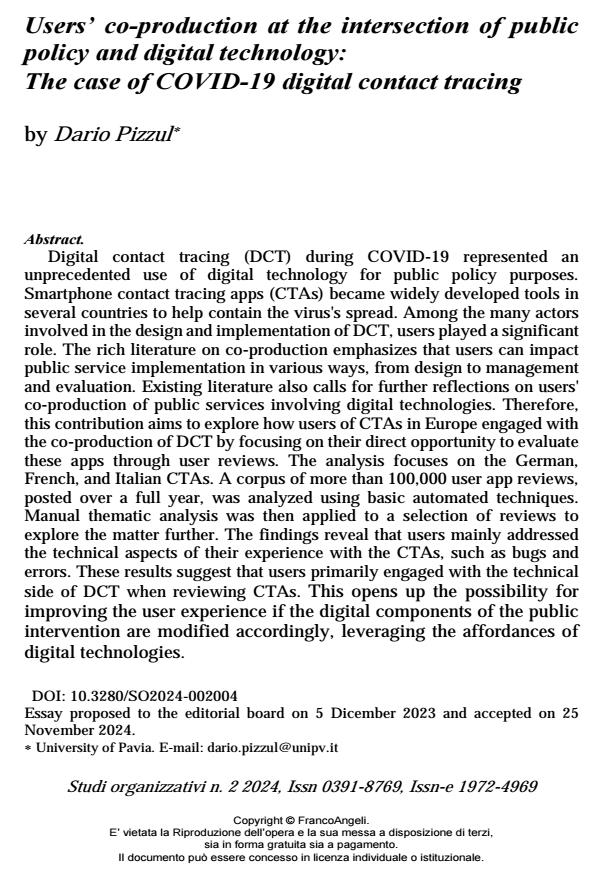Users’ co-production at the intersection of public policy and digital technology: The case of COVID-19 digital contact tracing
Titolo Rivista STUDI ORGANIZZATIVI
Autori/Curatori Dario Pizzul
Anno di pubblicazione 2025 Fascicolo 2024/2
Lingua Inglese Numero pagine 27 P. 73-99 Dimensione file 514 KB
DOI 10.3280/SO2024-002004
Il DOI è il codice a barre della proprietà intellettuale: per saperne di più
clicca qui
Qui sotto puoi vedere in anteprima la prima pagina di questo articolo.
Se questo articolo ti interessa, lo puoi acquistare (e scaricare in formato pdf) seguendo le facili indicazioni per acquistare il download credit. Acquista Download Credits per scaricare questo Articolo in formato PDF

FrancoAngeli è membro della Publishers International Linking Association, Inc (PILA)associazione indipendente e non profit per facilitare (attraverso i servizi tecnologici implementati da CrossRef.org) l’accesso degli studiosi ai contenuti digitali nelle pubblicazioni professionali e scientifiche
Digital contact tracing (DCT) during COVID-19 represented an unprecedented use of digital technology for public policy purposes. Smartphone contact tracing apps (CTAs) became widely developed tools in several countries to help contain the virus's spread. Among the many actors involved in the design and implementation of DCT, users played a significant role. The rich literature on co-production emphasizes that users can impact public service implementation in various ways, from design to management and evaluation. Existing literature also calls for further reflections on users' co-production of public services involving digital technologies. Therefore, this contribution aims to explore how users of CTAs in Europe engaged with the co-production of DCT by focusing on their direct opportunity to evaluate these apps through user reviews. The analysis focuses on the German, French, and Italian CTAs. A corpus of more than 100,000 user app reviews, posted over a full year, was analyzed using basic automated techniques. Manual thematic analysis was then applied to a selection of reviews to explore the matter further. The findings reveal that users mainly addressed the technical aspects of their experience with the CTAs, such as bugs and errors. These results suggest that users primarily engaged with the technical side of DCT when reviewing CTAs. This opens up the possibility for improving the user experience if the digital components of the public intervention are modified accordingly, leveraging the affordances of digital technologies.
Il digital contact tracing (DCT) durante COVID-19 ha rappresentato un uso inedito delle tecnologie digitali nell’ambito delle politiche pubbliche. Sin dalla prime fasi della pandemia, le app di contact tracing sono state sviluppate in molti Paesi, nel tentativo di contenere la diffusione del virus. Tra i molteplici attori coinvolti nella progettazione e implementazione del DCT, gli utenti hanno avuto un ruolo significativo. La ricca letteratura legata al concetto di co-produzione sottolinea che gli utenti possono influenzare l'implementazione dei servizi pubblici in vari modi, a partire dalla progettazione, ma anche rispetto alla loro gestione e valutazione. Però, relativamente alla co-produzione in ambito pubblico, con specifico riferimento al coinvolgimento delle tecnologie digitali, c’è spazio per ulteriori riflessioni. Pertanto, questo contributo mira a esplorare come gli utenti delle app di contact tracing in Europa abbiano partecipato alla co-produzione del DCT attraverso la possibilità di valutare le app ed esprimere opinioni con le recensioni sugli store online. L'analisi si focalizza sulle app di contact tracing tedesche, francesi e italiane. Un corpus di oltre 100.000 recensioni pubblicate nel corso di un anno è stato analizzato utilizzando tecniche automatizzate. Successivamente, un'analisi tematica manuale è stata applicata a una selezione di recensioni per aggiungere profondità alle considerazioni. I risultati suggeriscono che gli utenti hanno principalmente affrontato aspetti tecnici della loro esperienza con le app di contact tracing, come bug ed errori, e meno questioni più generali legate all’implementazione del DCT. Il ruolo degli utenti nello sviluppo del DCT suggerisce che ci sono possibilità significative per migliorare la loro esperienza intervenendo sulla parte digitale di una specifica politica pubblica, facendo leva sulle affordances delle tecnologie digitali stesse.
Parole chiave:digital contact tracing; contact tracing app; COVID-19; co-produzione; politiche pubbliche; design delle tecnologie.
Dario Pizzul, Users’ co-production at the intersection of public policy and digital technology: The case of COVID-19 digital contact tracing in "STUDI ORGANIZZATIVI " 2/2024, pp 73-99, DOI: 10.3280/SO2024-002004